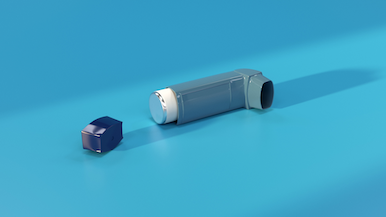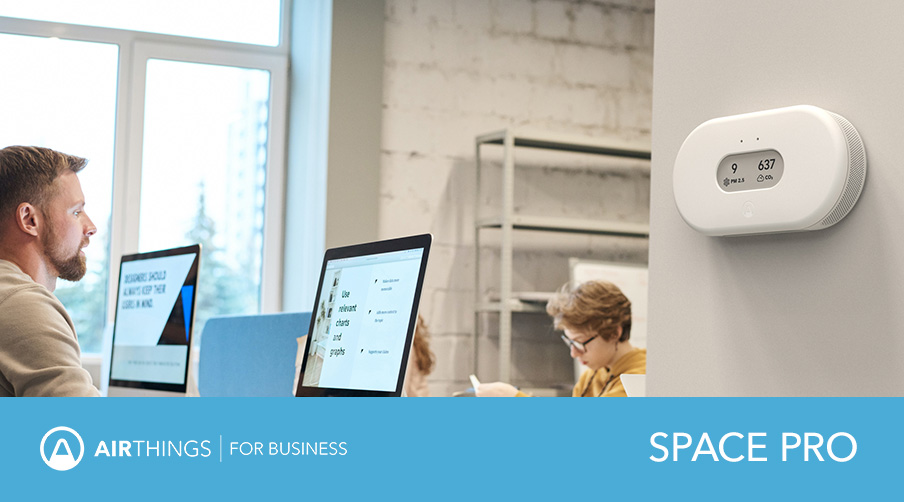Air pollution, especially particulate matter (PM) has been on the news constantly due to global warming and the impact it has on our health.
In this article, we break down the key things you need to know about PM so you can protect your business and employees.
91% of people living in cities do not breathe in safe air1
Contents:
What is particulate matter and why is it important?
Particulate matter is a range of particles of dust, dirt, and liquids that become suspended in the air2. Some of these are large enough to see, like smoke, smog, or soot.
However the most harmful are smaller, invisible particles. Helpfully, particulate matter is categorized by size. PM2.5 for example has a diameter of less than 2.5 microns. PM2.5 (also known as fine particles) can get into your lungs and even your bloodstream3. PM1 would therefore be smaller particles than Pm2.5. Simply put, the healthier the air, the fewer PMs in the workplace.


How does PM impact the health of people in offices, healthcare facilities and educational centers?
PM exposure, amongst others caused by emissions and industrial processes, is an important source of respiratory and cardiovascular diseases4. As these particles can become trapped indoors, especially with HVAC units bringing the ‘fresh’ air in from outside in, monitoring is vital.
WHO estimates that around 7 million people die every year from exposure to fine particles in polluted air5
On top of this, research shows that there are three key areas of our health which are impacted by PM pollution:
- Irritation of the eyes, ears, nose, and throat: Particulate matter can cause inflammation, even when the mucus membranes in your nose are doing their job and filtering out larger particles. Some studies show that breathing in PM is linked to a greater need for sinus surgery6. In the short-term it is likely to mean runny noses, sneezing, and itchy eyes7.
- Triggering of asthma and allergies: Because PM inflames the airways, people with asthma are particularly susceptible to its effects and it also contributes to the development of the disease8. PM is also linked to allergic respiratory reactions, like hay fever9. You can learn more about improving the lives of asthma sufferers through optimizing indoor air quality here.
- Aggravation of coronary and respiratory disease: The particles can cause flare-ups or worsen problems for people with coronary artery disease, congestive heart failure, or chronic obstructive pulmonary disease (COPD)10.
All of which can lead to employee dissatisfaction and of course increased sick days.
Educational centers and healthcare facilities are at risk too as research has suggested that pollution can affect people throughout their lifetime. One study found that children and older people are among the most vulnerable to the effects of PM11. Ensure your buildings are safe by monitoring levels of PM indoors with the Airthings Business solution.


How is PM generated?
PM comes from both man-made and natural sources outside. The man-made variety can be generated by industry, construction work, landfills, agriculture, motor vehicles with either petrol or diesel engines, and friction from brakes and tires12.
Whereas the natural sources include wildfires, pollen-producing plants, spray whipped up from water, soil, and even volcanoes and other seismic activities. ‘Secondary particles’ are created when gases react in the air to form PM. Nitrogen oxides emitted by traffic and some industrial gases can become solids or liquids in this way.13


What can I do to reduce PM levels in my workplace?
There are ways a business can protect employees from high PMs. As the primary source is from the air outside, which can become trapped indoors. Below we have compiled our easy steps to reduce PM levels in the workplace:
Step one: Monitor
First, you need to confirm that you have high levels of PM. The Airthings for Business solution is set up in a matter of minutes, with wireless monitors which run on long-lasting batteries, making PM monitoring easy.
Step two: investigate
Is it a continuous problem? And are all of your sensors reporting high PM levels? If it is just one area, this could be that something indoors is creating high levels. Similarly, if you have high levels only at certain times of day, this could be a result of an action. For example, high levels when the building is being cleaned could be the cause. Hoovering and other cleaning activities can stir up dust into the air, thus creating the readings.
Step three: investigate outdoors
Once you have confirmed that the problem is a continuous one, it may be time to investigate the outdoor air around your business. This is because polluted air from outside could be coming into your building. Airthings Dashboard provides local outdoor PM levels.
Step four: check your HVAC system
Check if your HVAC system is running as intended. If it is, by simply cleaning filters in ventilation systems regularly helps ensure that trapped particles are not recirculated throughout the building. Similarly, changing the filters in HVAC units will help ensure that the fresh air is coming in.
Step five: do you need to upgrade your filters?
There are numerous HVAC filters on the market, when experiencing high PM levels it could be time to upgrade to a filter with a higher rating. As you know, stronger filters will require more energy from the HVAC system to push the air through them. Using Airthings data to show elevated PM levels, can help you to justify the need for the upgrade to relevant parties.

Want to learn more about the most comprehensive indoor air quality monitor in the Airthings for Business solution, including PM, Noise, Radon and more? Get even more control over your space today with Space Pro (formerly View PLus for Business) →

Sources:
1. https://breathelife2030.org/news/infographic-library/
2. www.blf.org.uk/support-for-you/air-pollution/types
3. www3.epa.gov/region1/airquality/pm-human-health.html
4. www.sciencedirect.com/science/article/pii/S0925753518321349
5. https://www.who.int/airpollution/data/en/
6. www.ncbi.nlm.nih.gov/pmc/articles/PMC6635701/
7. www.health.ny.gov/environmental/indoors/air/pmq_a.html
8. www.ncbi.nlm.nih.gov/pmc/articles/PMC4465283/
9. www.sciencedirect.com/science/article/pii/S0954611115001870
10. www.epa.gov/indoor-air-quality-iaq/indoor-particulate-matter
11. www.ncbi.nlm.nih.gov/pmc/articles/PMC4740117/
12. /blog.breezometer.com/what-is-particulate-matter
13. /blog.breezometer.com/what-is-particulate-matter
 Most popular
Most popular

 Radon
Radon



 Radon
Radon
 Radon
Radon


.webp)






